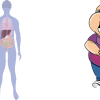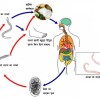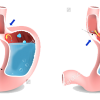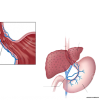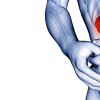Tag: gastrointestinal , nausea , nervous system , vomiting
-
Appendicitis
Appendicitis is the inflammation of the appendix. Appendix is a small, finger-shaped tubular structure attached to the large intestine located at the right side of lower abdomen. There is no known function of appendix in human body. When infected with bacteria or due to the blockage, the appendix gradually swells and g
-
Abdominal Pain
Pain felt between the ribcage and pelvis is called abdominal pain. It is a very common symptoms experienced by just about everyone at some point of time in their life. Abdominal pain can be generalised over entire abdomen or more commonly localised to one area. Based on the anatomic structure that gives rise to the pai
-
Black stools
Black stools can be due to bleeding in gastrointestinal (GI) tract or ingestion of certain medications (iron, bismuth) or certain food (blueberries). Black, tarry, sticky and smelly stool is caused by bleeding in the GI tract, and is known as melena. Malena is a serious medical
-
Constipation
Constipation is a common problem related to your bowel movement, when the stool is too hard, difficult to get out and occurs in small amount, less than three times a week. You might have abdominal cramps, may feel bloated or even sick if it is severe and prolonged. Why does
-
Ascariasis
Ascariasis is infestation of humans intestine by roundworm (Ascaris lumbricoides). The roundworm may reside in the guts for 6 to 24 months. The eggs are passed into the stool and under warm, shady, moist conditions they can survive for up to 10 years. The infection is transmitted by in
-
Pins and Needles
Tingling and numbness are the loss of normal sensation in the various parts of body. Tingling is the prickling sensation also known as pins and needles and it is usually felt in hands and feet. Numbness is when one cannot feel any sensation in part of his/her body. <
-
Nausea and Vomiting
Nauseas and vomiting are usually manifestation of some underlying disease that are usually non life threatening. Occasionally, it might be an indicator of underlying serious conditions like brain disease, intestinal obstruction and heart disease. Nausea is the feeling of uneasiness in th
-
Vomiting of blood (Hematemesis)
Hematemesis refers to the presence of blood in your vomit or vomiting of pure blood that originates in upper part of your gastrointestinal tract. It needs to be differentiated from spitting blood mixed saliva which arises from teeth, mouth and throat. It also need to be differentiated
-
Rabies
Rabies is a viral disease of mammals affecting the brain and the nervous system. It is transmitted to humans by the bite of a rabid animal. From the site of the bite, the virus travels via nerves to the brain. Then it spreads to other organs including, salivary gland and is shed in saliv
-
Heart Attack
Heart attack is a leading cause of death in adults. The medical term for heart attack is myocardial infarction. Heart attack occurs when the blood flow to the heart is severely reduced or completely blocked. The heart muscle needs regular supply of blood and oxygen to survive.
-
Diarrhea
Diarrhea is defined as increased frequency of defection (more than 3 per day) with excessive or abnormally loose consistency. Stool weights more than 200g/day are sometimes used to define diarrhoea but in the absence of abnormal consistency, weight alone is not an ideal indicator as bowel weight is influenced by high f
-
Gasteroesophageal Reflux Disease
Gasteroesophageal reflux disease (GERD) is also known as acid reflux. GERD occurs is when stomach contents leak backwards (called “reflux”) into esophagus and cause symptoms or complications. Reflux is a normal process in infant, child or adult, but when it causes troublesome s
-
Esophageal Varices
Esophageal varices are abnormally swollen veins in the lining of the lower esophagus. Most of the time, esophageal varices develop due to obstruction in the portal venous circulation (blood flow through the liver) but mainly it occurs when a healt
-
Amoebiasis/Giardiasis
Amoebiasis is an infection of gastrointestinal tract caused by an intestinal parasite called Entamoeba histolytica. It causes dysentery, liver abscess and rarely affects lungs, heart and brain. It occurs everywhere in the world but especially in the areas where there is poor sanitation and poor socioeconomic status. Th
-
Acid Reflux Disease
When we eat food, it travels through the mouth to the food pipe (esophagus) and then to the stomach. Once in the stomach, food cannot come back up into the esophagus under normal conditions because of the presence of the lower esophageal sphincter (LES). LES is a group of fiber muscle rings at the lower end of the food
-
Tetanus
Tetanus is a vaccine preventable disease of the nervous system caused by a bacteria Clostridium tetani. This organism is widely distributed in soil contaminated with animal and human feces. The spores formed by the bacteria can survive for years and is resistant to various disinfectants and even boi
-
Peptic Ulcer Disease
Peptic Ulcer Diseases (PUD) are conditions where the lining of the stomach and the duodenum (first part of the small intestine) are damaged leading to the formation of open sores. The stomach and duodenum are in constant contact with gastric juice but the presence of a protective layer o
-
Hookworm Infestation
Hookworm infestation is a parasitic disease of humans caused by one of the two organisms- Ancylostoma duodenale and Necator americanus. It is the second most common helminthic infection in developing world. Hookworms are found in soil contaminated by human feces. The transmission of infection occurs when the following


